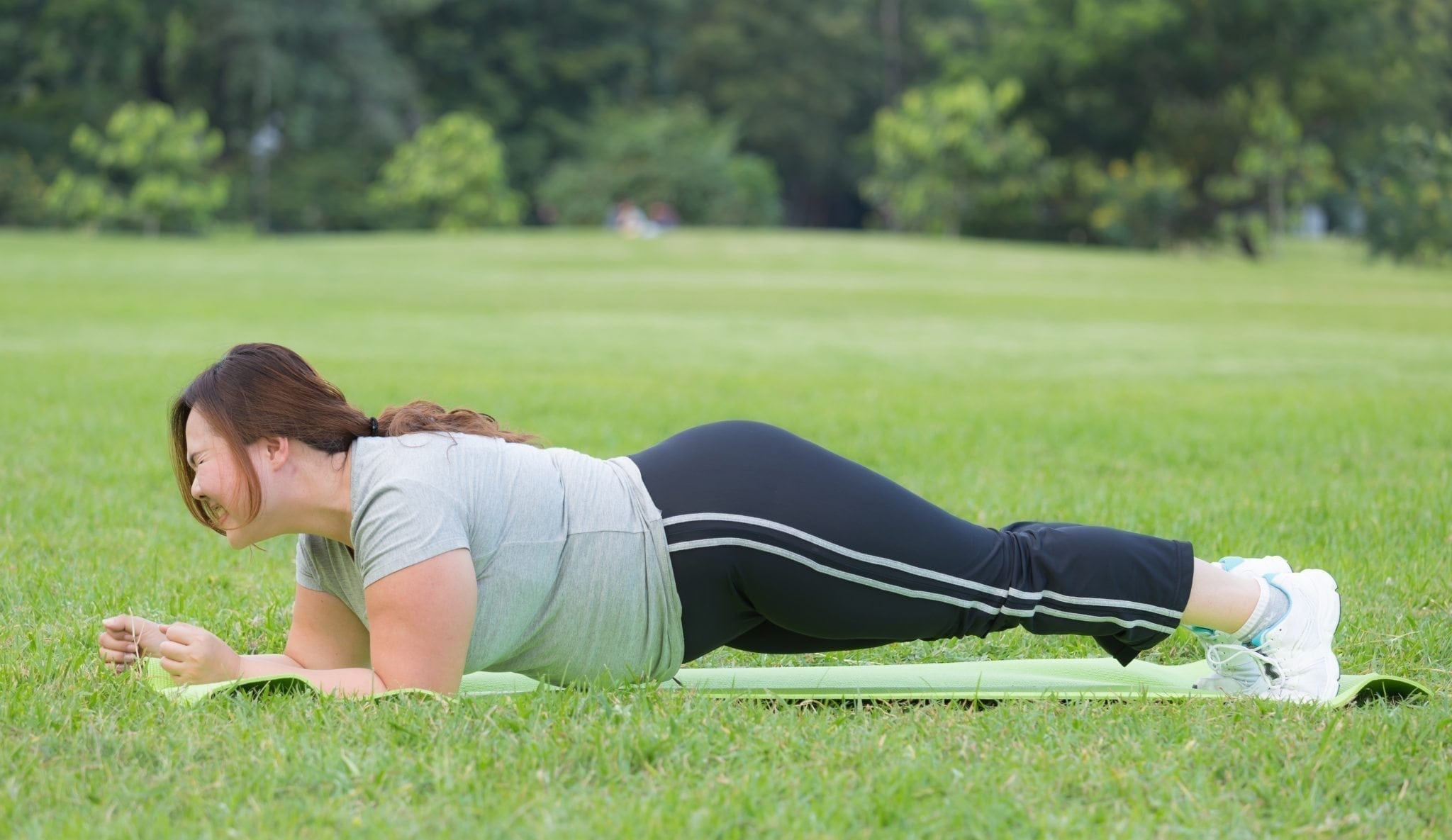Lower-back pain is the number one musculoskeletal complaint in America, according to a 2009 study. Fortunately, many of these aches and pains can be avoided with the right mix of exercises.
Your best bet to strengthen your back and avoid localized pain is to do the following:
- Increase hip mobility
- Build rock-solid core strength
- Complete strength moves that focus on your glutes and hamstrings
A careful blend of flexibility and strength moves can help relieve lower-back pain and keep it from coming back. If you’re experiencing back pain, go see a doctor first. If you’re cleared to exercise, give these movements a try:
1. All-Fours Belly Lift
Similar to the cat pose in yoga, the all-fours belly lift creates global flexion of the spine, which strengthens the abdominals and takes pressure off a tight lower back. If your back is overly arched, this exercise is a must-do before doing direct lower-back exercises.

- Start on all fours, and roll your belt buckle toward your chin.
- Round your upper back toward the ceiling by gently drawing your chest away from the floor.
- Be careful not to actively push your hands through the floor or hyperextend your elbows.
- Once you’ve created a rainbow shape with your back, inhale through your nose to fill your upper back with air.
- Gently exhale through your mouth until you’ve pushed all the air out of your belly without letting your chest drop toward the floor.
- You should feel your abs and obliques turn on while creating a stretch through your upper back.
- Repeat for 5–8 breaths.
2. Front Plank
The front plank challenges the muscles of the abs and lower back to work together to resist gravity. Whether used as a core-activation drill during your warm-up or a gut-busting ab exercise, the front plank is a staple for a healthy lower back.

- Start by lying on your stomach with your hands by your shoulders. Push your body off the floor as if you were going to do a push-up. If you have sensitive wrists, rest on your forearms.
- The key here is to keep a straight line from head to toe without letting your hips sag toward the floor or hike toward the ceiling.
- Clench your glutes as if you were trying to pinch a penny between your cheeks, and flex your abs as if someone was about to punch you in the gut.
- Try to hold this position for 30 seconds.
3. Barbell Supine Bridge
The lower back is perhaps best used as an endurance muscle that resists movement while your arms and legs move. Few exercises challenge the lower back in this capacity better than the barbell supine bridge. If you work a desk job and sit for most of the day, you might lose your ability to flex and extend your hips without moving through your back. The supine bridge restores and strengthens this motion.

- Begin seated on the ground with a loaded barbell over your legs (you can complete this exercise without weight as well). Using a fat bar or having a pad on the bar can greatly reduce the discomfort caused by this exercise. Roll the bar so that it is directly above your hips, and lay down flat on the floor.
- Begin the movement by driving through with your heels, extending your hips vertically through the bar. Your weight should be supported by your upper back and the heels of your feet.
- Extend as far as possible, then reverse the motion to return to the starting position.
- Make sure to press your lower back into the floor at the start of each rep. This puts your pelvis into a posterior tilt, which reduces stress on the spine and helps your glutes work harder. Protect your back while building your butt? It’s a win-win.
- If you don’t have a barbell, you can hold a dumbbell or kettlebell on your lap to add resistance or simply use your body weight for higher reps.
4. Back Extensions to Neutral
Back extensions are a bit of a double-edged sword. They can be a great lower-back exercise if done properly, but if done with poor form, they can cause more harm than good.
Back extensions performed with a neutral spine at the top position (i.e., stopping before you hyperextend your lower back) can strengthen your lower back while teaching you proper spinal alignment.

- Kneel on a back extension machine or on a stability ball, and place your hands behind your head.
- Lean forward and lengthen your body so your torso is resting against the ball and you’re firmly balanced on your toes.
- Make sure your spine forms a straight line from your tailbone to your neck.
- Lift your chest upward a few inches, hold a moment, and then slowly lower back down.
- Cross your arms over your chest, pull your abs in, and lower your upper body a few inches by bending forward at the hips.
- Raise back up, using your lower back, so your body is parallel to the floor.
- When done properly, you’ll feel these in your glutes and hamstrings, too. Remember, the lower back rarely works in isolation, but rather it functions to resist movement. If you only feel this in your lower back, you’re doing it wrong.
- Focus on keeping your belt buckle turned toward your chin and stopping when your torso is parallel to the floor.
5. Kettlebell Sumo Deadlift
Perhaps the best challenge of lower-back strength is the deadlift because it forces you to hold your back in one position while your legs move. If you can keep your back from rounding while holding heavy weight in your hands, you’re on the right path.

- Before you deadlift, make sure to fill your belly with air and squeeze your abs tight. This will stabilize your lower back and keep it from rounding as you go down to grab the weight.
- Straddle a kettlebell with your feet slightly wider than shoulder width. Squat down with arms extended down between your legs, and grasp the kettlebell handle with an overhand grip with both hands. Position your shoulders over the kettlebell with a taut low back and your trunk close to vertical.
- Pull the kettlebell off the floor by extending your hips and knees. Stand upright with your chest high. Lower kettlebell to the ground between your legs while squatting down with a taut lower back and trunk close to vertical.
- Keep your feet flat on floor, hips low, and back taut throughout the lift. Your knees should point in the same direction as your feet throughout the movement. Don’t jerk the weight off of the floor.
We’ve Got Your Back
Try these 5 exercises to build a strong, resilient lower back. Remember, your back is meant for endurance, not for hoisting the weight all by itself. Proper technique is the key, so practice until perfect form is second nature.




